Tuesday, 7th September 2021
Rising Antimicrobial Resistance in India
Rising Antimicrobial Resistance in India
In News
Indian Council of Medical Research (ICMR), in its latest report on ‘antimicrobial resistance research and surveillance’ has highlighted the growing antimicrobial resistance across India.
Highlights of the Report
- Sustained increase in Drug Resistance: There has been a sustained increase in drug-resistant pathogens and an increase in the number of cases that were hard to treat with currently used antimicrobials.
- Overuse of Antimicrobials: There has been an overuse of antimicrobials. The pathogen that showed increased drug resistance was the cause of secondary infection in many serious Covid-19 cases.
- Organisms that posed the biggest threat: Escherichia Coli (E Coli), klebsiella pneumoniae, pseudomonas aeruginosa, acinetobacter baumannii and staphylococcus aureus. These are usually found at tertiary care hospitals showed increased drug resistance.
- The report calls for immediate antibiotic stewardship programmes in hospitals to cut down on unnecessary prescription of antimicrobials.
- Diagnostic stewardship is mandated to ensure that appropriate antimicrobials are used after identifying the pathogen to reduce antibiotic pressure on the pathogens that is the key driver of antimicrobial resistance

What is Antimicrobial Resistance?
- Antimicrobial Resistance (AMR) occurs when bacteria, viruses, fungi, and parasites mutate over time and no longer respond to medicines which makes infections harder to be treated and increases the risk of disease spread, severe illness and death.
- AMR is brought about by decades of overuse and misuse of antibiotics, antivirals, antifungals and antiparasitics.
Source:
- Antimicrobial Resistance is rising in India, says ICMR report
- Drug resistance to fungal infections increasing: ICMR report
- Antimicrobial Resistance
Image Source:
Swarm Drone Systems
News
The Indian army has place it’s first-ever order for swarm drone systems which are capable of surveillance and attack missions.
About the News
- The army has taken the lead in swarm drones–considered as the future of warfare–by placing a Rs 200-cr order on Indian startups to supply a system capable of surveillance, electronic warfare, and kinetic attack.
- While the air force is also looking at swarm drones, the army has taken the lead to order the system, catching up with similar efforts in the US, UK, Russia, and China to use multiple drones for carrying out coordinated military missions.
- The procurement of drones is a part of ‘Revolution in Military Affairs’, known as RMA, which changes the way the war is fought.

What is Swarm drone technology?
- Swarm robotics is an approach to the coordination of multiple autonomous robots as a system which consists of a large number of mostly physical robots, controlled by minimal human intervention.
- These exhibit collective self organising (SO) behaviour through interaction and cohesion between robots, as well as interaction of robots with the environment.
- Swarming algorithms are empowered by biological studies of swarm behaviour of insects, fishes, birds and animals.
- In a true swarm, each of the drones flies itself following onboard AI to maintain formation and avoid collisions with algorithms mimicking nature.
- There is no true leader and follower, with all agents in a swarm having their own ‘mind’ able to undertake collective decision-making, adaptive formation flying, and self-healing.
- Once unleashed, an armed, fully autonomous drone swarms(AFADS) with distributed AI will locate, identify, and attack targets without human intervention.
- In India, the Indian Air Force has been pioneering swarm drone research and development with its Meher Baba initiative since 2019. This is geared towards in depth humanitarian assistance and disaster relief (HADR) operations.
- Countries that possess the Drone swarm technology include the USA, UK, France, Russia, and China.
Source –
Third-party apps turn on UPI autopay mode
In News
The National Payments Corporation of India (NPCI) UPI Autopay service, which was launched last year, is gaining traction with top merchants such as Netflix and Hotstar signing up.
About the News
- Reason for the Increase: Reserve Bank of India (RBI) rules for card-based transactions through standing instructions that take effect next month.
- Gaining Momentum: UPI Autopay service, launched in 2020, is gaining traction after a slow start.Two of India’s largest over-the-top (OTT) streaming services, Netflix and Disney+ Hotstar, went live on UPI Autopay this month.
- Doubling volumes: Two million monthly mandates on UPI Autopay are being registered which is double the volume National Payments Corporation of India (NPCI) is doing on NACH mandates.

- NACH or National Automated Clearing House is used by companies and financial institutions to handle bulk payments.
- Top Banks: State Bank of India, Paytm Payments Bank and Bank of Baroda are the three top banks live on UPI Autopay.
About Autopay Service
- Autopay allows users to make recurring transactions below Rs 5,000 through UPI apps.
- Autopay’s such as loan repayments, rent payments, educational fees and subscriptions are currently taking place through card-based mandates.
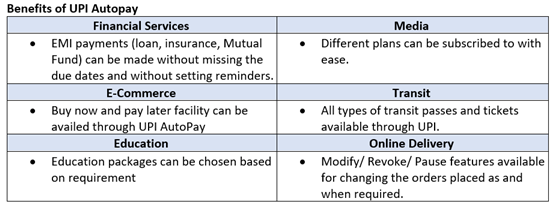
Sources:
Dinosaurs in Thar
This is the image of footprints of three species of dinosaurs that have been found in the Thar Desert in Rajasthan’s Jaisalmer district, proving the presence of the giant reptiles in the western part of the State, which formed the seashore to the Tethys Ocean during the Mesozoic era. They belong to three species of dinosaurs — Eubrontes cf. giganteus, Eubrontes glenrosensis and Grallator tenuis.

Source:
Hydropower projects in Himalayas
In News
Recently, three Central Ministries, which initially had dissenting views on the future of hydroelectric power projects, have given a go ahead to seven hydroelectric power projects in the Himalayas.
About the News
- The seven projects are the Tehri Stage 2, Tapovan Vishnugadh (which was impacted by the February flood), Vishnugadh Pipalkoti, Singoli Bhatwari, Phata Bhuyang, Madhyamaheshwar and Kaliganga 2.
- Although these projects got their environmental clearance based on very different parameters, but now they are being approved on uniform criteria, reflecting the negligence in the context of climate change and anthropogenic activity.
The Potential and Vulnerabilities of the Himalayas to the Hydropower projects
- India’s Hydropower Potential: It is estimated that India has a potential of about 145,320 megawatts (MW) of hydropower and around 78 percent of that is in the Himalayan states, which have the potential for over 112,000 MW.
- Hydropower work in Himalayas: The pace and magnitude of hydropower development in Himachal Pradesh has been the highest. The highest identified potential of hydropower amongst the five river basins of Himachal lies in the Satluj valley.
- Vulnerability of the Himalayas:42% of the total geographical area of Himachal Pradesh is prone to landslides, according to the Geological survey of India.
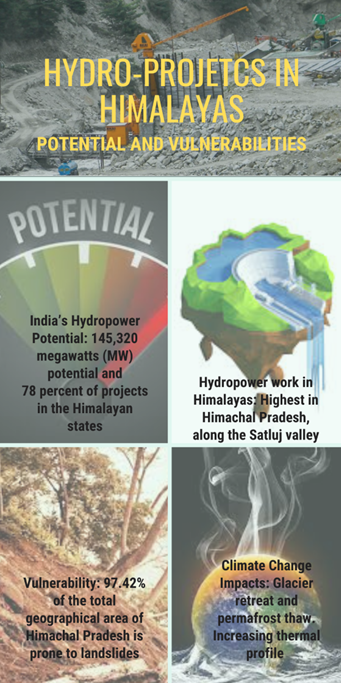
- Climate Change Impacts: Glacier retreat and permafrost thaw are projected to decrease the stability of mountain slopes and increase the number and area of glacier lakes.
- The thermal profile of ice in the Himalayas is increasing, making it more susceptible to melting.
What has been the impact of Hydropower projects in Himalayas?
- Problematic Compensatory Afforestation: Under compensatory afforestation, of the average number of total saplings reported, only 10 percent of saplings were found to exist. While the trees that were cut down were mostly of local and indigenous species, the plantations consist of a proportionately higher number of exotic and invasive
- Global green growth agendas: The climate change mitigation is largely relying on the fallacy that ecological damages in one region can be simply compensated by repair measures in another.
- Ecology and Habitat Destruction: Forest land diverted for such projects in Himachal Pradesh, has revealed that construction activities for hydropower projects have not only impacted existing land-use, but also disturbed forest biodiversity and fragmented the forest landscape.
- The Cascading Effect: Given the diverse and fragile Himalayan ecosystem, the link between the increasing number of natural disasters and the numerous hydropower construction projects in the high mountain valleys cannot be denied.
- With increased instances of cloudbursts, and intense spells of rainfall and avalanches, residents of the region were placed at increased risk of loss of lives and livelihood.
- Impact on local water bodies: In mountain terrain, there is a space crunch and the designated ‘dumping sites’ are invariably along the river, edges of roads.
- The Niti Aayog commissioned study highlighted that nearly half of the perennial springs have already dried up or have become seasonal in the Himalayan belt. Springs in the higher reaches are the key source of water for domestic uses as well as irrigation.
- Impact on Local Structures: Blasting carried out during underground construction activities of Hydropower projects, locals often report earthquake like tremors, damaging surface structures, especially houses, fields and roads.
Why are Hydro-power projects being permitted despite the high level of destruction potentials?
- Knowledge Gap: Most projects have not taken into consideration the tectonic and seismic sciences on the Himalayas. It is very crucial aspect w.r.t. the capacity of a structure to withstand high-intensity earthquakes.
- The Economy-Ecology Tussle: Absence of baseline data makes it difficult to establish scientific linkages between construction and damage to environment, and at the time of impact assessment studies, there is a rush to complete the studies to get speedy clearances.
- Renewable energy status: In 2019, the government declared that large hydropower projects would have renewable energy status even as they have been severely criticised for having a huge impact on the area where they are planned.
- Geo-strategic Water war: The rapid expansion of hydropower projects in the region is not fuelled only by a desire to produce clean energy. The continuing “water war” between India and its neighbours is also a motivating factor behind the mushrooming of these projects in the Indian Himalayas.
- Co-Benefits Justification: Governments anticipate several developmental benefits of energy transition such as cheaper, reliable energy, revenues from export of “green” fuel, access to international development finance, and increased local business opportunities. These are referred to as “co-benefits” in climate policy discourses.
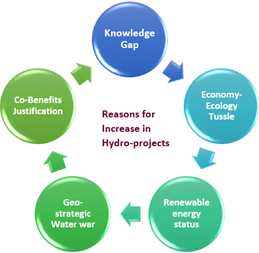
What needs to be done to balance the Energy generation with Ecological considerations?
- Pause and Ponder: The need of the hour is a pause on hydropower in the Himalayas to stop further devastation. There needs to be a complete stop to subsidies to the hydropower sector based on the ‘green’ tagging.
- Effective Impact Assessment: An independent scientific review or assessment of the immediate or long-term implications of construction work for hydropower development especially in the Himalayas should be commissioned. A revision of terms of reference of impact assessment studies should be done based on such review.
- Strict Compliance: There should be an independent inquiry or audit of the social, environmental and safety norms compliance of all under-construction and operational projects, specifically projects where accidents have already been reported. A dam safety law can be considered.
- Stakeholder’s involvement: Citizens’ engagement and public consent mechanisms need to be strengthened at the planning stage and a grievance redressal mechanism for addressing issues brought forth by public needs to be put in place post clearance.
Conclusion: Global green growth agendas are driving and legitimising projects in the ecologically sensitive regions, in the name of mitigation causing more harm to fragile local ecosystems and indigenous local people. There is need to confront the current idea of mitigation relying on the fallacy that ecological damages in one region can be simply compensated by repair measures in another.
Question: Discuss the impact of Hydro-power projects in the Himalayas. What are the reasons for increase in the number of these projects?
Sources:
- Ministries reach consensus on hydropower projects in Himalayas:
- Explained | Why are hydropower projects in the Himalayas risky?
- Hydropower projects ruining lives in the Himalayas
- The-Hidden-Cost-of-Hydropower_2019Hydropower projects are wreaking havoc in the Himalayas
- Large hydro projects risk Himalayan communities
- Hydropower not a very ‘green’ solution in Himachal Pradesh, finds study
Boxer Rebellion
On September 7, 1901, the Boxer Rebellion formally ended with the signing of the Boxer Protocol. Boxer Rebellion was officially supported peasant uprising of 1900 that attempted to drive all foreigners from China. “Boxers” was a name that foreigners gave to a Chinese secret society known as the Yihequan (“Righteous and Harmonious Fists”). The group practiced certain boxing and calisthenic rituals in the belief that this made them invulnerable. Their original aim was the destruction of the dynasty and also of the Westerners who had a privileged position in China.

Sources:
Air Gun Surrender Abhiyan
- Context: Air Gun Surrender Abhiyan is a new hope for biological conservation in Arunachal Pradesh.
- ‘Air Gun Surrender Abhiyan’ is a state government initiative inviting people to voluntarily surrender their air guns/pistols to stop indiscriminate killing of birds in Arunachal Pradesh.
- Hunting has been a community practice for many communities in Arunachal Pradesh. It has increased manifold with the proliferation of air guns and rifles, found freely in markets.
- The traditional bamboo traps used for hunting birds (that did not exterminate them) have been replaced by air guns that have the capability to wipe out the entire species.
- To combat this, the initiative was launched in March 2021, at Lumdung village in East Kameng District, where 46 air guns were surrendered.
- In return, the person got a certificate of appreciation and so far, 420 air guns from more than 20 villages have been surrendered.
- The programme is voluntary and aimed at gradually easing villagers into the concept of conservation.
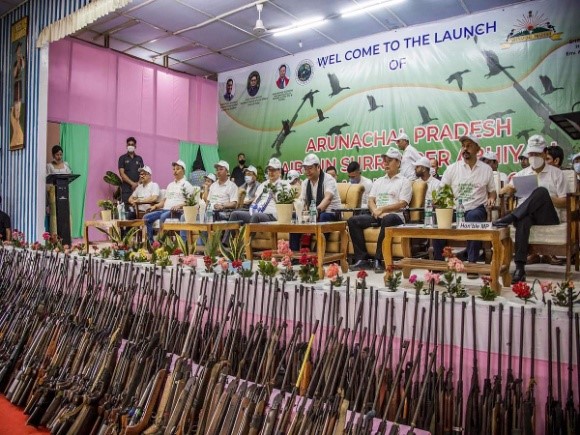
Source:
- Taking the air out of air guns: a conservation initiative in Arunachal Pradesh aims to save the birds
- Air gun surrender could be conservation’s silver bullet
Image source:
UAE’s Green and Golden Visas
- Context: The United Arab Emirates (UAE) has announced a new class of visas called ‘Green Visas’ and is set to expand the scope of ‘Golden Visas’.
- The Green visas will allow expats to apply for work without being sponsored by an employer.
- It expands the self-residency status to investors, entrepreneurs, highly skilled individuals, top students, and graduates, thus attracting talent and boosting growth investors.
- The Green Visa holders can sponsor their parents and children up to the age of 25 on their permits.
- The Golden visa introduced in 2019 (which covers the spouse, children, parents of the visa holder), allows foreigners to live, work and study in the UAE without the need of a national sponsor and with 100% ownership of their business.
- The visa has a tenure of 5 or 10 years with investment requirements set down (For instance a 10-year visa requires a minimum investment of Emirati Dirham (AED) 10 million.

Source:
- UAE to introduce Green visa to attract talent and funds, plans to expand scope of golden visa
- UAE launches ‘green visas’ in a bid to target investors, highly skilled workers
Image source:
Manda buffalo
- Context: The National Bureau of Animal Genetic Resources (NBAGR) has recognized the Manda buffalo, as the 19th unique breed of buffaloes found in India.
- The Manda buffalo is found to inhabit the Eastern Ghats and the plateau of Koraput region of Odisha.
- It is a small, sturdy breed that is resistant to parasitic infections, less prone to diseases and can live, produce, and reproduce at low or nil input system.
- They contribute to the nutrition of households and are used for agricultural operations like ploughing in the undulated hilly terrain of Koraput, Malkangiri and Nabarangpur districts of Odisha.
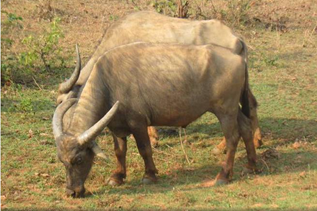
Source:
- Odisha: Koraput’s Manda buffalo gets unique, indigenous tag
- Manda buffalo of Odisha's Koraput gets national recognition
Image Source:
Ingenuity
- Context: NASA's helicopter on Mars, Ingenuity is said to have completed 12 flights.
- NASA’s Ingenuity is the first aircraft to have attempted powered flight on another planet, Mars.
- Launched in 2020, it was carried by NASA’s rover called Perseverance and landed on the red planet following a seven-month voyage through space.
- The tiny copter (1.8 kilogram) has survived the glacial cold of Martian nights, drawing warmth from the solar panels that charge its batteries during the day.
- The tiny helicopter has become the regular travel companion of the rover Perseverance, whose core mission is to seek signs of ancient life on Mars.

Source:
- After Six Months on Mars, NASA's Tiny Helicopter Is Still Flying High
- Explained: Why the flight by Ingenuity, the first helicopter on Mars, is a big deal
- After six months on Mars, NASA’s tiny copter is still flying high
Image source:
Is Pakistan the victor in Afghanistan, or a part of its spoils?- IE
Essence: Pakistan has received special significance as moderators between countries around the world and Afghanistan after the Taliban takeover of Kabul. But Pakistan’s ability to leverage the international interest depends on its ability to control the internal dynamic in Afghanistan. One needs to believe that today the spoils of the Afghan war belong to Pakistan. Pakistan’s victory in Afghanistan might make it a bigger nuisance for India and the region but is unlikely to reverse the steady relative decline of Pakistan’s comprehensive national power over the last few decades.
Why should you read this article?
- To get an overview of Afghanistan’s issue and role of Pakistan in it.
- To understand the interest of Pakistan in Afghanistan and its impact on India.
Topic- Is Pakistan the victor in Afghanistan, or a part of its spoils?
Source :
States should stop whining and must fix their own finances
Essence: States are struggling to meet their expenditure needs. For their financial woes, States tend to blame the center by pointing out issues like lack of autonomy in using funds allocated under Centrally Sponsored Schemes and lesser say in deciding rates under GST.
While the author finds states’ grievance related to increasing use of cesses and surcharges by center as valid, he defends the center’s other fiscal decisions as prudent. Article in fact points out that the bias in the scheme of resource transfer to states and autonomy over their use has over time shifted in favor of states. Article concludes that given center’s own fiscal compulsions, states themself will have to generate finances to get on to a virtuous cycle of growth and development.
Why should you read this article?
- To understand issues related to fiscal federalism in India.
- To understand other side of the narrative that fiscal arrangement is always skewed against states.
Source:
The long and the short of the NMP
Essence: The editorial raises pertinent issues associated with the National Monetization Pipeline. Assets identified for monetization are performing assets- strategic and significant- such as National Highways and Pipelines. Ordinary citizens are double taxed as they paid taxes to create the assets and would now pay higher user charges. Government has other avenues for mobilizing resources such as increase the tax to GDP ratio, improvements in tax compliance and plugging loopholes. It will help in increasing the tax revenue of the country. Example: Companies that had declared they were not earning any profits had increased from 40% in 2005-06 to over 51% in 2018-19.
Why you should read this article?
- To understand the various issues associated with National Monetization Pipeline.
- To understand the alternatives to resource mobilization
Source:
Women Farmers and Poshan Vatika
Background
- The pandemic led to relocation of migrant workers.
- No alternative income and lack of nutrition and food in the urban areas.
Nutrition gardening as a ray of hope
- Female workforce: Women from 12 villages of the district established Poshan Vatika in the Mendki Tal, Chhindwara, Madhya Pradesh.
- Addressing hunger: It helped communities to address nutritional deficiencies due to cultivation of nutritional vegetable and other food items such as spinach, tomato, ginger, coriander, cucumber, lemon, guava, etc.
- Income generation: Surplus produce let to income generation at the times when getting bare minimum income was a dream for many.
Other benefits
- Revamp of ecosystem: Barren land were transformed into nutritious food garden.
- Waste management: Scaffolds were installed for vines and compost pits were dug for organic manure.
- Health aspect: This ensured good health of pregnant women and children in the villages of the district.
- Work culture: Increased work efficiency resulted in better agricultural results.
- Awareness: Nutritional and immunity related awareness was inculcated among family members through trainers and NGO workers.
Quote
“A woman is the full circle. Within her is the power to create, nurture and transform.” – Diane Mariechild
Where can it be used
Paper 1: Role of Women and Women’s Organization, Social Empowerment
Paper 2: Issues relating to Poverty and Hunger.
Source:
Share the article
Get Latest Updates on Offers, Event dates, and free Mentorship sessions.

Get in touch with our Expert Academic Counsellors 👋
FAQs
UPSC Daily Current Affairs focuses on learning current events on a daily basis. An aspirant needs to study regular and updated information about current events, news, and relevant topics that are important for UPSC aspirants. It covers national and international affairs, government policies, socio-economic issues, science and technology advancements, and more.
UPSC Daily Current Affairs provides aspirants with a concise and comprehensive overview of the latest happenings and developments across various fields. It helps aspirants stay updated with current affairs and provides them with valuable insights and analysis, which are essential for answering questions in the UPSC examinations. It enhances their knowledge, analytical skills, and ability to connect current affairs with the UPSC syllabus.
UPSC Daily Current Affairs covers a wide range of topics, including politics, economics, science and technology, environment, social issues, governance, international relations, and more. It offers news summaries, in-depth analyses, editorials, opinion pieces, and relevant study materials. It also provides practice questions and quizzes to help aspirants test their understanding of current affairs.
Edukemy's UPSC Daily Current Affairs can be accessed through:
- UPSC Daily Current Affairs can be accessed through Current Affairs tab at the top of the Main Page of Edukemy.
- Edukemy Mobile app: The Daily Current Affairs can also be access through Edukemy Mobile App.
- Social media: Follow Edukemy’s official social media accounts or pages that provide UPSC Daily Current Affairs updates, including Facebook, Twitter, or Telegram channels.





